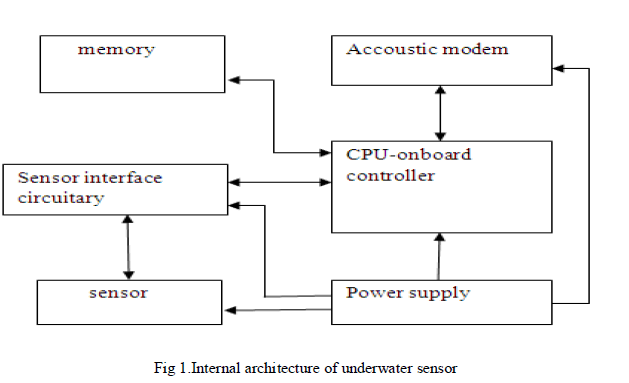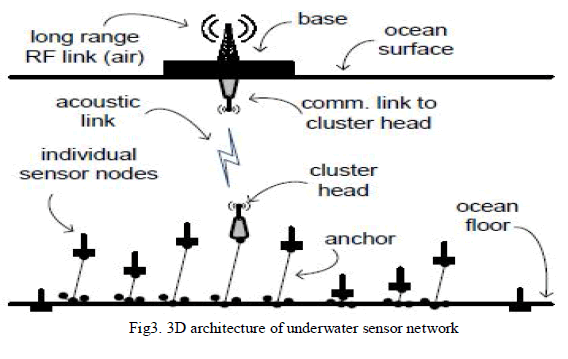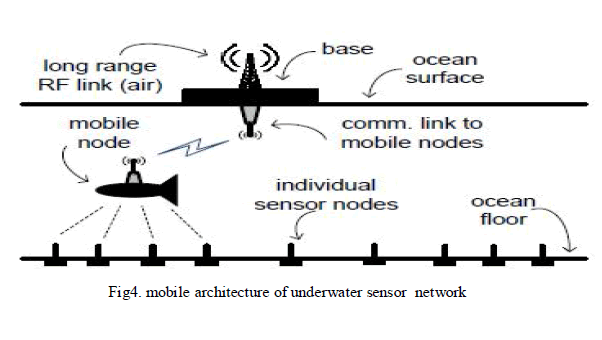ISSN ONLINE(2278-8875) PRINT (2320-3765)
ISSN ONLINE(2278-8875) PRINT (2320-3765)
Jaydip M. Kavar1, Dr.K.H Wandra2
|
| Related article at Pubmed, Scholar Google |
Visit for more related articles at International Journal of Advanced Research in Electrical, Electronics and Instrumentation Engineering
In our earth 75% covered by water that could be river and ocean also. The underwater sensor network are enabling technology and become more and more popular for monitoring vast area of oceans. Underwater sensor Networks consist of a variable number of sensors that are deployed to perform monitoring tasks over a given area. The UWSNs provide countinuous monitoring for various applications like ocean sampling network, pollution monitoring, submarine detection,disaster prevention,etc. In this paper, we discuss the internal architecture of underwater sensor,we discussed the literature of underwater sensor network,different architectures for two-dimensional and three-dimensional underwater sensor networks are discussed, we also discussed the application and main problem or issue in underwater sensor network.
Keywords |
| UWSN,UW-sink,AUV,UUV,Routing |
INTRODUCTION |
| Earth is largely covered by water. This is largely unexplored area and recently humans are showing interest towards exploring it Underwater Acoustic Sensor Networks (UW-ASN) consist of a variable number of sensors that are deployed to perform the monitoring tasks over a given area. Many disasters that took place in recent past made humans to greatly monitor the oceanic environments for scientific, environmental, military needs etc., in order to perform these monitoring task industries are showing interest towards deploying sensor nodes under water. |
| TWSNs operate in an environment dominated by RF communication. Yet, RF communication is not an optimal communication channel for underwater applications because of the extremely limited RF wave’s propagation underwater. conductive sea water only at extra low frequencies (30 ¡ 300 Hz), which require large antennae and high transmission power. Thus, links in underwater networks are based on acoustic wireless communications [1] Acoustic communications are the typical physical layer technology in underwater networks. |
| The accoustic communication,while more reliable and robust,is bandwidth limited.underwater accoustic rates are between 5kb/s and 20kb/s,which is extremely slow compared to over air RF rate(in Gb/s)[1]. |
A. Internal architecture of underwater sensor |
| The internal architecture of underwater sensor is shown in fig1. |
| In internal architecture the CPU-on board controller,sensor interface circuitary,accoustic modem,memory,power supply and sensor are main component[2]. |
 |
| It consist of the main controller which is interfaced with sensor through a sensor interface circuitary.The CPU or controller receive the data from the sensor and stored it in the memory, process it and send to the anothere sensor through the accoustic modem.Sometimes all the sensor component are protected by the Bottom-mounted instrument frames that are design to permit azimuthally omnidirectional communications,and protect the sensor and modem from potential impact of trawling gear[2]. |
| In this paper we discussed the literature survey of underwater sensor network in section 2,.In section 3 we discussed the main useful application in underwater sensor network.In section 4 we discussed the different types of architecture that currently used in underwater sensor network.In section 5 we discessed we discussed the main challenges or problem on underwater sensor network. |
II. LITERATURE SURVEY |
| The terrestrial sensor network and underwater sensor network are different in many factors.The comparision between terrestrial sensor network and underwater sensor network are bellow[2]. |
| A.Signal:In the terrestrial sensor network there are radio sgnal will be used but in underwater sensor network there are accoustic signal will be used because radio signal will work with extra low frequency so it can not travel far in underwater so it is not feasible. |
| B.Power:In underwater sensor network power required is more compare to terrestrial sensor network because the signal will travelling in water medium and the another reason is high distance among sensors and complex environment. |
| C.Memory:In terrestrial sensor has limited storage capacity but underwater sensor may need to be able to do some data caching so,its require more memory. |
| D.Cost:Underwater sensors are more costly whereas terrestrial sensors are not more costly compare to underwater sensors and moreover the underwater sensor require additional hardware protection system. |
| Today very increasing demand to some special routing protocol which can work efficiently.For the current point of research scenario underwater sensor network with some different routing protocol available which play some specific role in underwater sensor network[3]. |
| There are mainly four protocol family in underwater sensor network. |
| 1) Flooding based routing protocols |
| 2) Multipath based routing protocols |
| 3) Cluster based routing protocols |
| 4) Miscellaneous based routing protocols |
| Flooding based routing protocols:In the flooding based routing protocols the nade transmitting the packet to all other node within transmission range.There are many protocol in flooding based family like HH-VBF(hop-by-hop vector based forwarding protocol),DBR(depth based routing protocol),FBR(focus beam routing protocol),HH-DAB(hop-byhop dynamic address based routing protocol),SBR-DLP(sector-based routing with destination location prediction) etc. |
| Multipath based routing protocols:In multipath based there are more than one path are establish from source node to destination node.In multipath based routing include Winston et al. Scheme, Dario Pompili et al. Scheme, MPT etc. |
| Cluster based routing protocol:In this types of scheme there are group of node.There are two types of node in this scheme, cluster head node and cluster member node.In cluster based include MCCP(minimum cost clustering protocol),DUCS(distributed underwater clustering scheme),Hydro cast etc. |
| Miscellaneous based routing protocols:In miscellaneous based protocol include adaptive,ICRP(information carrying based routing protocol),phero-trail etc. |
III. APPLICATION S OF UNDERWATER SENSOR NETWORK |
| A. Fastest way for finding underwater information:Underwater sensor is the latest and fastest way of finding information which is available in underwater sensor network This information is not only helpful for human being but also responsible for researchers[4]. |
| B. Disaster Prevention: Disaster prevention is also very important characteristics of Underwater sensor network system able to perform seismic activity which provide tsunami warnings to coastal areas[4]. |
| C. Ocean Sampling Networks:Autonomous underwater vehicles able for cooperative adaptive sampling of the 3D coastal ocean environment.In 3D environment. we can arranged the sensor in different different depth in ocean.so we can sense the ocean area at different depth[5]. |
| D. Environmental Monitoring:Environment monitoring is one of the most important application of UWSN. In environment monitoring include polution monitoring,monitoring of ocean currents,improve weather forecast are other possible applications[5]. |
| E. Mine Reconnaissance:The simultaneous operation of multiple AUVs with accoustic sensor can be used to perform rapid environmental and detect mine like object[5]. |
| F. Distributed Tactical Surveillance:AUV and fixed underwater sensor can collaboratively monitor areas for surveillance, reconnaissance and intrusion detection systems[5]. |
IV. UNDERWATER SENSOR NETWORK ARCHITECTURE |
| UWSN architectures can be classified in various ways. One classification discriminates between static, semi-mobile, and mobile architectures.Another popular UWSN classification method is to divide UWSNs into two-dimensional (cover ocean floor) and three-dimensional (includes depth as a dimension). UWSN can also be single-hop, multi-hop, or hybrid (single-hop individual sensors, multi-hop clusters). Architectures can be grouped into short-term, time-critical applications, and long-term, non-time-critical applications.RF, optical, and acoustic wave based architectures are another way to look at the available UWSNs[5]. |
| Fig. 2 shows the most common UWSN architecture. The individual nodes are anchored at the ocean floor. They are usually smaller in size, battery operated, and they mostly transmit data via acoustic modems. The cluster heads are also anchored to the ocean floor. In addition to having acoustic modems. Cluster heads are equipped with two acoustic transceivers,namely a vertical and a horizontal transceiver. The horizontal transceiver is used by the cluster head or uw-sink to communicate with the sensor nodes in order to[6]: |
| i) send commands and configuration data to the sensors.This communication will happening between underwater sink or cluster head to sensors. ii) collect monitored data.This communication will happening between sensors to cluster head or sink.Cluster heads communicate via horizontal acoustic modes with all other individual nodes within the cluster. The data transfer from node to cluster head can be single-hop (each node communicated to the cluster head directly) or multi-hop. In case of multi-hop paths, as in terrestrial sensor networks [6], the data produced by a source sensor is relayed by intermediate sensors until it reaches the uw-sink. This results in energy savings and increased network capacity but increases the complexity of the routing functionality as well.The vertical transreceiver is used by the uw-sinks to relay data to a surface station. Vertical transceivers must be long range transceivers for deep water applications as the ocean can be as deep as 10 km. The surface station is equipped with an acoustic transceiver that is able to handle multiple parallel communications with the deployed uw-sinks. Finally base or suface station will send the sensed data to on-shore base station via RF signal[6]. |
 |
| Unlike TWSNs, the hardware of the cluster head node is different from all other nodes, because it has additional functionalities such as a direct communication link with the ocean surface. Therefore, a popular TWSN’s cluster head switching feature (which increases the overall network lifetime by efficiently distributing the power consumption among nodes) cannot be utilized inUWSNs. Also, the cluster head is potentially the most security-vulnerable component in UWSNs military applications, because it is a single point of failure node. |
| Fig. 3 shows an alternative 3D UWSN architecture.Three dimentional underwater networks are used to detect and observe phenomena that cannot be adequately observed by means of ocean bottom sensor node,i.e.,to perform cooperative sampling of 3D ocean environment. |
| In 3D architecture ,sensor node float at different depth in order to observe the given phenomenon. In this architecture each sensor is ancchored to the ocean bottom and eqquiped with a floating buoy that can inflated by a pump.The buoy pushes the sensor towards the ocean surface. The depth of sensor then can be regulated by adjusting the length of wire that connect the sensor to the anchor,by means of an electronocally controlled engine that reside on sensor.[7] |
| 3D architecture can have all nodes directly communicate to the surface base or can have only cluster heads communicate directly to the base. In the former case, all nodes are of the same type, but communication might be more energy intensive than that of the cluster head approach. The cluster head approach requires only the cluster head to carry a long-range communication modem. On the other hand, the clustered approach is vulnerable to single point of failure. Military applications are extremely sensitive to single point of failure hardware components. |
| In 3D architecture ,sensor node float at different depth in order to observe the given phenomenon. In this architecture each sensor is ancchored to the ocean bottom and eqquiped with a floating buoy that can inflated by a pump.The buoy pushes the sensor towards the ocean surface. The depth of sensor then can be regulated by adjusting the length of wire that connect the sensor to the anchor,by means of an electronocally controlled engine that reside on sensor.[7] |
| 3D architecture can have all nodes directly communicate to the surface base or can have only cluster heads communicate directly to the base. In the former case, all nodes are of the same type, but communication might be more energy intensive than that of the cluster head approach. The cluster head approach requires only the cluster head to carry a long-range communication modem. On the other hand, the clustered approach is vulnerable to single point of failure. Military applications are extremely sensitive to single point of failure hardware components. |
 |
| Many challenges arise with such an architecture, that need to be solved in order to enable 3D monitoring, including: Sensing coverage:Sensors should collaboratively regulate their depth in order to achive the full column coverage according to their sensing ranges.Hence it possible to obtain sampling of desired phenomenon at all. |
| Communication coverage:Since in 3D underwater networks there is no notion of uw-sink, sensors should be able to relay information to the surface station via multihop paths. Thus, network devices should coordinate their depths such a way that the network topology always connected, i.e., at least one path from every sensor to the surface station always exists. |
 |
| The next architecture uses AUVs and UUVs as network nodes. Fig. 4.3 shows an example of the architecture. |
| The main important factor in this architecture is a mobility of nodes. Mobile node put extra controlling complexity in the network.In addition the network consume more power because they consume extra power due to force or movement of mobile node in water.Moreover the mobile node is less reliable and shorter lifetime. |
| Both mobile and static architecture has some advantages and disadvantages.so,we need hybrid architecture to highlight or underlne the advantages of both architecture.In hybrid architecture that include uses both mobile node and static node by which we can transmit our sensed data efficiently from floor sensor to surface station[7].In this this architecture the mobile node traversing over the static field or static sensor and achive the point-to-point communication.The static sensor node transmit the data to water surface station via mobile node [8]. |
V. PROBLEM IN UNDERWATER SENSOR NETWORK |
| A. More costly devices : Underwater sensor devices are more costly. And no more supplier are provides these such kind of devices because these are devices are part of research oriented activity. Underwater sensor devices are not easily available in the market[9]. |
| B. Hardware Protection requirement :The underwater devices is more expensive . So device protection or hardware protection is required against water[9]. |
| C. Needed high power for communication: In underwater sensor communication require more power because the data transfer will done in water medium.So,in water more electricity is require for data exchanging. Communication among UWSNs is probably the biggest challenge facing UWSNs. point out that path loss (attenuation and geometric spreading), noise (man-made and ambient), multi-path, high propagation delays, and Doppler spread, can significantly disrupt or degrade the underwater communication channel. Another problem is that standard acoustic transducers cannot simultaneously transmit and receive. Underwater network communications are therefore always halfduplex[ 10]. |
| G. Propagation delay: The propogation delay is major problem in underwater sensor network.The propogation of accoustic channels in underwater is order of magnitude higher than radio frequency in terrestrial sensor network[10]. |
| H. Localization:Localization means find the location of sensor in underwater sensor network.So,localization is another major problem yet to be solved. Localization is the challenging factor that is require for data labeling while some time critical applications require data without time delay[10]. |
| I. Limited battery power:UWSN lifetime is an area of extensive research. UWSNs suffer from a sensor’s fouling and corrosion . Electronics components, such as the battery, tend to degrade faster under extremely low temperatures such as the one found in deep underwater. As a consequence, the USWN lifetime is much shorter than the lifetime of a comparable TWSN. In underwater sensor battery has limited power. A shorter lifetime increases the replacement costs because the underwater sensor battery is not chargable[10]. |
| J. Bandwidth size limitation:In the underwater sensor network bandwidth is another big problem. Because bandwidth size is limited[11]. |
| K. Reliability : This is one of the major design issues for reliable delivery of sensed data to the surface sink or water surface is a challenging task compare to forwarding the collected data to the control center or on-shore station[11]. |
| F. Temporary losses: Temporary losses means the packet losses when connectivity time and packet sending time[11]. |
VI. CONCLUSION |
| In this paper we introdused the underwater sensor network.We present the main application of underwater sensor network.In this paper we also introdused the architecture of underwater sensor network, routing family and main challenges of underwater sensor network. |
| We plan to continue our UWSN study.We expect a fair amount of time on physical layer,because many challenges outlined in our paper are directly related to UWSN’s physical layer.Also we expect the time on to make efficient routing in underwater sensor network. |
References |
|